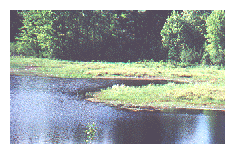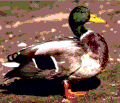Approximately a dozen
ducks were observed by Pat Mattson on March 15,  2000 in the open water and marshland near
French Hall. (see "open water" and "emergent vegetation" on the
Hackett Hill
Wetlands Map.) Those ducks
that were close enough to be identifiable were male and female
mallards.
2000 in the open water and marshland near
French Hall. (see "open water" and "emergent vegetation" on the
Hackett Hill
Wetlands Map.) Those ducks
that were close enough to be identifiable were male and female
mallards.
The mallard is a duck species which is widespread throughout the northern hemisphere. Mallards are about 2 feet in length. The adult male (shown here) can be distinguished by its glossy greenish black head and throat and white collar and brown breast.. The female has a brownish back and white undersides, spotted with brown.
 The
habitats of mallards are marshlands, ponds, rivers, and the ocean.
The ducks forage for food by tipping their bodies into the water
headfirst. Their tail simultaneously rises in the air. Mallards
primarily eat seeds of aquatic vegetation but may also eat snails,
small insects and fish, and mosquito larvae.
The
habitats of mallards are marshlands, ponds, rivers, and the ocean.
The ducks forage for food by tipping their bodies into the water
headfirst. Their tail simultaneously rises in the air. Mallards
primarily eat seeds of aquatic vegetation but may also eat snails,
small insects and fish, and mosquito larvae.
Mallards are migratory waterfowl. They winter in the southern U.S., and central America and arrive at their nesting grounds between March and April. Female mallards build nests on the ground that are well protected by dense vegetation. The eggs will hatch sometime between March and July. The young mallards leave the nest soon afterwards and can fly within 11/2 to 2 months.
Credits: The photograph of the male mallard is from the
Patuxent
Wildlife Research Center.
![]() PERTINENT LINKS
PERTINENT LINKS